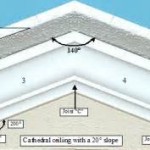Are you looking for a way to add a touch of class and elegance to your home? If so, you should consider installing a tongue and groove ceiling. This type of ceiling offers a timeless look that will enhance any home’s decor. Plus, it’s easy to install and maintain, making it an ideal choice for homeowners who want a beautiful and durable ceiling solution.
Tongue and groove ceilings have been around for centuries, and they remain popular today. The “tongue” is the part of the board that fits into the “groove” of the adjoining board. This allows the boards to fit together snugly, creating a seamless and uniform look. The boards can be made of a variety of materials, including wood, vinyl, and even metal. Depending on your personal preference, you can choose a color, texture, and finish that will perfectly complement your home’s design.
Advantages of Tongue and Groove Ceilings
Tongue and groove ceilings have a number of advantages that make them a great choice for any home. These include:
- Easy installation: Unlike traditional drywall ceilings, tongue and groove ceilings are easy to install. All you need is a few basic tools and some basic carpentry skills. Plus, the boards snap together easily, so you don’t have to worry about spending hours measuring and cutting boards to fit.
- Durability: Tongue and groove ceilings are incredibly durable, and they can last for decades with proper maintenance. This makes them ideal for high-traffic areas, such as kitchens and bathrooms.
- Versatility: Tongue and groove ceilings can be painted or stained, allowing you to customize the look of your ceiling. Plus, they can be installed on flat or vaulted ceilings, giving you even more design options.
- Low maintenance: Once installed, tongue and groove ceilings require very little maintenance. They don’t require frequent painting or staining, and they won’t warp, crack, or peel over time.
Disadvantages of Tongue and Groove Ceilings
While tongue and groove ceilings have many advantages, there are a few potential drawbacks. These include:
- Cost: Tongue and groove ceilings can be more expensive than traditional drywall ceilings. This is because the individual boards must be purchased separately and snapped together, which can be time-consuming and costly.
- Installation: Installing tongue and groove ceilings can be more difficult than installing drywall ceilings. This is because the boards must be precisely cut and fitted together. If you’re not an experienced carpenter, you may want to hire a professional to install your ceiling.
- Noise: Tongue and groove ceilings can let more sound through than drywall ceilings, which can be a concern in homes with multiple levels or open floor plans.
Conclusion
Tongue and groove ceilings are a great choice for homeowners who want to add a touch of class and elegance to their home. They’re easy to install and maintain, and they can last for decades with proper care. However, they can be more expensive than drywall ceilings, and they may let more sound through than drywall ceilings. If you’re considering installing a tongue and groove ceiling in your home, make sure to weigh the advantages and disadvantages before making your decision.















Related Posts








